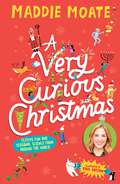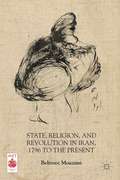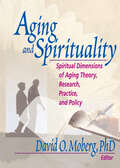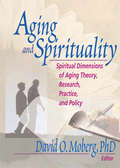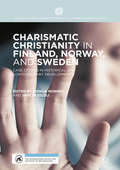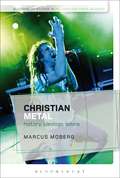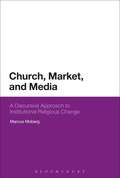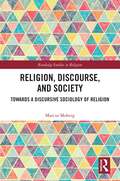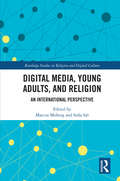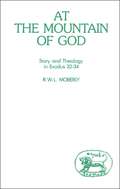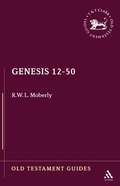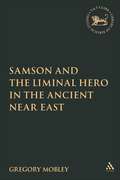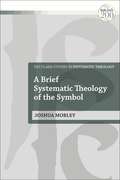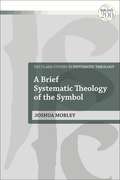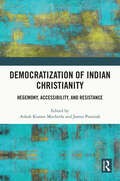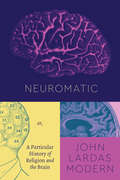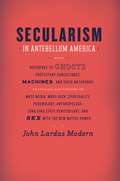- Table View
- List View
A Very Curious Christmas: Festive fun and seasonal science from around the world
by Maddie MoateHave you ever wondered why crackers go bang? Or where Christmas trees come from? Or why brussels sprouts make you fart?Maddie Moate is here to answer these questions and many more! From how toys work to where gingerbread comes from.You'll explore the science behind fairy lights, snowflakes, reindeer knees AND holly leaves!And you'll discover how different people around the world celebrate the Christmas period, and the curious history behind festive traditions.Prepare to be amazed at the wackiest Christmas facts - including upside-down Christmas trees, flying panto fairies, and presents delivered by a goat.Plus, every chapter includes wintery activities and craft ideas to get you in the holiday spirit!
State, Religion, and Revolution in Iran, 1796 to the Present (Middle East Today)
by B. MoazamiTwo basic assumptions have shaped understanding of recent Iranian history. One is that Shi'ism is an integral part of Iran's religious and cultural landscape. The other is that the ulama (religious scholars) have always played a crucial role. This book challenges these assumptions and constructs a new synthesis of the history of state and religion in Iran from 1796 to the present while challenging existing theories of large-scale political transformation. Arguing that the 1979 revolution has not ended, Behrooz Moazami relates political and religious transformations in Iran to the larger instability of the Middle East region and concludes that turmoil will continue until a new regional configuration evolves.
Aging and Spirituality: Spiritual Dimensions of Aging Theory, Research, Practice, and Policy
by David O. MobergExplore the spiritual dimensions of aging through science, theory, and practice!During the later years of life, many people devote energy to a process of spiritual awakening and self-discovery. Yet their family, friends, clergy, and the helping professionals who work with them are not always prepared to understand or deal with the spiritual concerns of their clients. Aging and Spirituality provides a unique, far-reaching overview of this long-neglected field.Divided into four independent but interwoven sections, this landmark book covers the spiritual realm with scientific rigor and deep human understanding. Aging and Spirituality comprehensively surveys the issues of spirituality, from the groundwork of basic definitions to detailed assessments of the role spirituality plays in the lives of the elderly and suggested directions for further research. This book's unique approach combines scholarly research and practical nuts-and-bolts suggestions for service delivery. By drawing from many disciplines and professions, it offers fresh perspectives to even those practitioners already familiar with the most effective spiritual techniques their own field can offer. Aging and Spirituality answers such common questions as: What are the spiritual needs of people later in life? Is there any solid evidence that prayer changes things? How is spirituality related to physical and mental health? Does spirituality matter when people know they are dying? How can we measure spiritual wellness and assess the outcomes of activities intended to enhance it? Will attention to spirituality aggravate or alleviate the losses--of friends, family, health, youth--that so often occur during old age?Aging and Spirituality provides a much-needed resource for health care professionals, clergy, social workers, and counselors working with geriatric clients. By integrating spiritual issues into the theoretical framework of social gerontology, Aging and Spirituality will help you understand the scientific foundations, practical applications, and public policy implications of spirituality for older adults.
Aging and Spirituality: Spiritual Dimensions of Aging Theory, Research, Practice, and Policy
by David O. MobergExplore the spiritual dimensions of aging through science, theory, and practice!During the later years of life, many people devote energy to a process of spiritual awakening and self-discovery. Yet their family, friends, clergy, and the helping professionals who work with them are not always prepared to understand or deal with the spiritual concerns of their clients. Aging and Spirituality provides a unique, far-reaching overview of this long-neglected field.Divided into four independent but interwoven sections, this landmark book covers the spiritual realm with scientific rigor and deep human understanding. Aging and Spirituality comprehensively surveys the issues of spirituality, from the groundwork of basic definitions to detailed assessments of the role spirituality plays in the lives of the elderly and suggested directions for further research. This book's unique approach combines scholarly research and practical nuts-and-bolts suggestions for service delivery. By drawing from many disciplines and professions, it offers fresh perspectives to even those practitioners already familiar with the most effective spiritual techniques their own field can offer. Aging and Spirituality answers such common questions as: What are the spiritual needs of people later in life? Is there any solid evidence that prayer changes things? How is spirituality related to physical and mental health? Does spirituality matter when people know they are dying? How can we measure spiritual wellness and assess the outcomes of activities intended to enhance it? Will attention to spirituality aggravate or alleviate the losses--of friends, family, health, youth--that so often occur during old age?Aging and Spirituality provides a much-needed resource for health care professionals, clergy, social workers, and counselors working with geriatric clients. By integrating spiritual issues into the theoretical framework of social gerontology, Aging and Spirituality will help you understand the scientific foundations, practical applications, and public policy implications of spirituality for older adults.
Charismatic Christianity in Finland, Norway, and Sweden: Case Studies in Historical and Contemporary Developments
by Jessica Moberg Jane SkjoldliThis is open access under a CC BY 4.0 licenseThe history of Charismatic Christianity in the Nordic countries reaches as far back as Pentecostalism itself. The bounds of these categories remain a topic of discussion, but Nordic countries have played a vital role in developing this rapidly spreading form of world-wide Christianity. Until now, research on global Charismatic Christianity has largely overlooked the region. This book addresses and analyzes its historical and contemporary trajectories in Finland, Norway, and Sweden. Through a selection of cases written by Nordic scholars from various disciplines, it demonstrates historical and contemporary diversity as well as interconnections between local, national, and global currents. Highlighting change and continuity, the anthology reveals new aspects of Charismatic Christianity.
Charismatic Christianity in Finland, Norway, and Sweden: Case Studies in Historical and Contemporary Developments
by Jessica Moberg Jane SkjoldliThis is open access under a CC BY 4.0 licenseThe history of Charismatic Christianity in the Nordic countries reaches as far back as Pentecostalism itself. The bounds of these categories remain a topic of discussion, but Nordic countries have played a vital role in developing this rapidly spreading form of world-wide Christianity. Until now, research on global Charismatic Christianity has largely overlooked the region. This book addresses and analyzes its historical and contemporary trajectories in Finland, Norway, and Sweden. Through a selection of cases written by Nordic scholars from various disciplines, it demonstrates historical and contemporary diversity as well as interconnections between local, national, and global currents. Highlighting change and continuity, the anthology reveals new aspects of Charismatic Christianity.
Christian Metal: History, Ideology, Scene (Bloomsbury Studies in Religion and Popular Music)
by Marcus MobergChristian metal has always defined itself in contrast to its non-Christian, secular counterpart, yet it stands out from nearly all other forms of contemporary Christian music through its unreserved use of metal's main musical, visual, and aesthetic traits. Christian metal is a rare example of a direct combination between evangelical Christianity and an aggressive and highly controversial form of popular music and its culture. Christian Metal: History, Ideology, Scene is the first full exploration of the phenomenon of Christian metal music, its history, main characteristics, development, diversification, and key ideological traits from its formative years in the early 1980s to the present day. Marcus Moberg situates it in a wider international evangelical cultural environment, accounts for its diffusion on a transnational scale, and explores what religious meanings and functions Christian metal holds for its own musicians and followers. Engaging with wider debates on religion, media and popular culture, Christian Metal: History, Ideology and Scene is a much-needed resource in the study of religion and popular music.
Christian Metal: History, Ideology, Scene (Bloomsbury Studies in Religion and Popular Music)
by Marcus MobergChristian metal has always defined itself in contrast to its non-Christian, secular counterpart, yet it stands out from nearly all other forms of contemporary Christian music through its unreserved use of metal's main musical, visual, and aesthetic traits. Christian metal is a rare example of a direct combination between evangelical Christianity and an aggressive and highly controversial form of popular music and its culture. Christian Metal: History, Ideology, Scene is the first full exploration of the phenomenon of Christian metal music, its history, main characteristics, development, diversification, and key ideological traits from its formative years in the early 1980s to the present day. Marcus Moberg situates it in a wider international evangelical cultural environment, accounts for its diffusion on a transnational scale, and explores what religious meanings and functions Christian metal holds for its own musicians and followers. Engaging with wider debates on religion, media and popular culture, Christian Metal: History, Ideology and Scene is a much-needed resource in the study of religion and popular music.
Church, Market, and Media: A Discursive Approach to Institutional Religious Change
by Marcus MobergMarcus Moberg offers a new model of religion and religious life in the post-war era, through focusing on the role of markets and media as vectors of contemporary social and cultural change – and therefore institutional religious change. While there is wide agreement among sociologists of religion that there this area is transforming on a global scale, there is less agreement about how these changes should best be approached and conceptualized. In a time of accelerating institutional religious decline, institutional Churches have become ever more susceptible to market-associated discourse and language and are ever more compelled to adapt to the demands of the present-day media environment. Using discourse analysis, Marcus Moberg tracks how new media and marketing language and concepts have entered Christian thinking and discourse. Church, Market, and Media develops a framework that approaches changes in the contemporary religious field in direct relation to the changing socioeconomic makeup of contemporary societies on the whole. Through focusing on the impact of markets and media within the contemporary religious setting of mainline institutional Christian churches in the Western world, the book outlines new avenues for further theorizing the study of religious change.
Church, Market, and Media: A Discursive Approach to Institutional Religious Change
by Marcus MobergMarcus Moberg offers a new model of religion and religious life in the post-war era, through focusing on the role of markets and media as vectors of contemporary social and cultural change – and therefore institutional religious change. While there is wide agreement among sociologists of religion that there this area is transforming on a global scale, there is less agreement about how these changes should best be approached and conceptualized. In a time of accelerating institutional religious decline, institutional Churches have become ever more susceptible to market-associated discourse and language and are ever more compelled to adapt to the demands of the present-day media environment. Using discourse analysis, Marcus Moberg tracks how new media and marketing language and concepts have entered Christian thinking and discourse. Church, Market, and Media develops a framework that approaches changes in the contemporary religious field in direct relation to the changing socioeconomic makeup of contemporary societies on the whole. Through focusing on the impact of markets and media within the contemporary religious setting of mainline institutional Christian churches in the Western world, the book outlines new avenues for further theorizing the study of religious change.
Religion, Discourse, and Society: Discourse Theory and Analysis for the Sociology of Religion (Routledge Studies in Religion)
by Marcus MobergThis book focuses on the utility and application of discourse theory and discourse analysis in the sociological study of religious change. It presents an outline of what a ‘discursive sociology of religion’ looks like and brings scholarly attention to the role of language and discourse as a significant component in contemporary processes of religious change. Marcus Moberg addresses the concept of discourse and its main meta-theoretical underpinnings and discusses the relationship between discourse and ‘religion’ in light of previous research. The chapters explore key notions such as secularism and public religion as well as the ideational and discursive impact of individualism and market society on the contemporary Western religious field. In addition to providing scholars with a thorough understanding and appreciation of the analytic utility of discourse theory and analysis in the sociological study of religious change, the book offers a cohesive and systematized framework for actual empirical analysis.
Religion, Discourse, and Society: Discourse Theory and Analysis for the Sociology of Religion (Routledge Studies in Religion)
by Marcus MobergThis book focuses on the utility and application of discourse theory and discourse analysis in the sociological study of religious change. It presents an outline of what a ‘discursive sociology of religion’ looks like and brings scholarly attention to the role of language and discourse as a significant component in contemporary processes of religious change. Marcus Moberg addresses the concept of discourse and its main meta-theoretical underpinnings and discusses the relationship between discourse and ‘religion’ in light of previous research. The chapters explore key notions such as secularism and public religion as well as the ideational and discursive impact of individualism and market society on the contemporary Western religious field. In addition to providing scholars with a thorough understanding and appreciation of the analytic utility of discourse theory and analysis in the sociological study of religious change, the book offers a cohesive and systematized framework for actual empirical analysis.
Digital Media, Young Adults and Religion: An International Perspective (Routledge Studies in Religion and Digital Culture)
by Marcus Moberg Sofia SjöIt has become increasingly clear that an adequate understanding of the contemporary processes of social, cultural, and religious change is contingent on an appreciation of the growing impact of social media. Utilising results of an unprecedented global study, this volume explores the ways in which young adults in seven different countries engage with digital and social media in religiously significant ways. Presenting and analysing the findings of the global research project Young Adults and Religion in a Global Perspective (YARG), an international panel of contributors shed new light on the impact of social media and its associated technologies on young people’s religiosities, worldviews, and values. Case studies from China, Finland, Ghana, Israel, Peru, Poland, and Turkey are used to demonstrate how these developments are progressing, not just in the West, but across the world. This book is unique in that it presents a truly macroscopic perspective on trends in religion amongst young adults. As such, it will be of great interest to scholars working in religious studies, digital media, communication studies, sociology, cultural studies, theology and youth studies.
Digital Media, Young Adults and Religion: An International Perspective (Routledge Studies in Religion and Digital Culture)
by Marcus Moberg Sofia SjöIt has become increasingly clear that an adequate understanding of the contemporary processes of social, cultural, and religious change is contingent on an appreciation of the growing impact of social media. Utilising results of an unprecedented global study, this volume explores the ways in which young adults in seven different countries engage with digital and social media in religiously significant ways. Presenting and analysing the findings of the global research project Young Adults and Religion in a Global Perspective (YARG), an international panel of contributors shed new light on the impact of social media and its associated technologies on young people’s religiosities, worldviews, and values. Case studies from China, Finland, Ghana, Israel, Peru, Poland, and Turkey are used to demonstrate how these developments are progressing, not just in the West, but across the world. This book is unique in that it presents a truly macroscopic perspective on trends in religion amongst young adults. As such, it will be of great interest to scholars working in religious studies, digital media, communication studies, sociology, cultural studies, theology and youth studies.
At the Mountain of God: Story and Theology in Exodus 32-34 (The Library of Hebrew Bible/Old Testament Studies)
by R. W. MoberlyAn introduction on appropriate methods of handling a narrative text leads into an exegesis of Exodus 32-34 in which it is argued that there is a deeper literary and theological coherence in these chapters than has been generally appreciated. There appears a striking account of Israel's relationship with God and the role of Moses within this. The exegesis promotes a discussion of the genre and purpose of Exodus 32-34 and also a preliminary reassessment of the possible growth and development of the material. As a result of the study both the distinctiveness and also the theological importance of Exodus 32-34 within the Moses tradition are set in a new light.
Genesis 12-50 (Old Testament Guides)
by R. W. MoberlyWalter Moberly's study Guide to Genesis 12-50 provides an invaluable introduction to the second part of Genesis and is essential reading for anyone interested in the patriarchal narratives and the earliest history of the people of Israel.
Samson and the Liminal Hero in the Ancient Near East (The Library of Hebrew Bible/Old Testament Studies)
by Gregory MobleyThe primary problem that Mobley's book deals with is the odd character of Judges 13-16 and of its hero. Samson's special quality, noted by virtually all interpreters, is defined here as liminality. The liminal situation, which includes a movement away from society, the lack of social restraints, and the status of outsider, is a permanent condition for Samson. The secondary purpose of this book is to demonstrate the ways in which the Samson saga, which is often compared to the Greek Heracles tradition, makes use of ideas about wild men and warriors found in other biblical and Mesopotamian stories.
A Brief Systematic Theology of the Symbol (T&T Clark Studies in Systematic Theology)
by Joshua MobleyHow do Christians understand the Trinity? How does this understanding relate to other Christian teachings? In conversation with key thinkers in contemporary and classical theology, particularly Henri de Lubac, Karl Rahner, Thomas Aquinas and Augustine, this book argues that a theology of symbols can help us glimpse the mystery of the Trinity and see how this central Christian teaching corresponds to Christian understandings of creation, humanity and the church. A symbol is not here understood as an arbitrary sign, but as a sign that mediates the presence of the symbolized. Joshua Mobley examines the understanding of the Father as “symbolized” in the Son who is the “symbol” of the Father by the “symbolism” of the Spirit, the personal agent of unity between Father and Son. These trinitarian relations then structure creaturely relations to God: God is symbolized in creation, which is a symbol of God by participation in the Son, and the church is symbolism, the union of creation with God by the power of the Spirit. Mobley thus argues that a theology of symbol helps coordinate trinitarian theology with key themes in Christian dogmatics.
A Brief Systematic Theology of the Symbol (T&T Clark Studies in Systematic Theology)
by Joshua MobleyHow do Christians understand the Trinity? How does this understanding relate to other Christian teachings? In conversation with key thinkers in contemporary and classical theology, particularly Henri de Lubac, Karl Rahner, Thomas Aquinas and Augustine, this book argues that a theology of symbols can help us glimpse the mystery of the Trinity and see how this central Christian teaching corresponds to Christian understandings of creation, humanity and the church. A symbol is not here understood as an arbitrary sign, but as a sign that mediates the presence of the symbolized. Joshua Mobley examines the understanding of the Father as “symbolized” in the Son who is the “symbol” of the Father by the “symbolism” of the Spirit, the personal agent of unity between Father and Son. These trinitarian relations then structure creaturely relations to God: God is symbolized in creation, which is a symbol of God by participation in the Son, and the church is symbolism, the union of creation with God by the power of the Spirit. Mobley thus argues that a theology of symbol helps coordinate trinitarian theology with key themes in Christian dogmatics.
Democratization of Indian Christianity: Hegemony, Accessibility, and Resistance
by Ashok Kumar Mocherla James PonniahThis book highlights the transformative potential of democratic Church and Christian community in India. In the light of both ongoing and, also to some extent, foregone sociopolitical and theological challenges confronting Indian Christianity, this book invokes the need to democratize Indian Christianity in terms of its theology, liturgy, teachings, practices, resources, leadership roles, and institutional power relations/sharing by keeping contemporary “social realities” of Indian Christians at the core of its approach and discourse. It explores internal challenges – of caste, class, gender, and regional contestations – and external forces of communalism and majoritarianism confronting Indian Christianity today. Further, it underlines the importance of dignity, equality, fraternity, freedom, and responsibility emerging at an organizational level through strong mechanisms of deliberation, decision-making, and execution. A major contribution to religious studies in India, this book will be of great interest to scholars and researchers of religion, especially Christian theology, South Asian studies, politics, and sociology.
Democratization of Indian Christianity: Hegemony, Accessibility, and Resistance
by Ashok Kumar Mocherla James PonniahThis book highlights the transformative potential of democratic Church and Christian community in India. In the light of both ongoing and, also to some extent, foregone sociopolitical and theological challenges confronting Indian Christianity, this book invokes the need to democratize Indian Christianity in terms of its theology, liturgy, teachings, practices, resources, leadership roles, and institutional power relations/sharing by keeping contemporary “social realities” of Indian Christians at the core of its approach and discourse. It explores internal challenges – of caste, class, gender, and regional contestations – and external forces of communalism and majoritarianism confronting Indian Christianity today. Further, it underlines the importance of dignity, equality, fraternity, freedom, and responsibility emerging at an organizational level through strong mechanisms of deliberation, decision-making, and execution. A major contribution to religious studies in India, this book will be of great interest to scholars and researchers of religion, especially Christian theology, South Asian studies, politics, and sociology.
Neuromatic: Or, A Particular History of Religion and the Brain (Class 200: New Studies in Religion)
by John Lardas ModernJohn Modern offers a powerful and original critique of neurology’s pivotal role in religious history. In Neuromatic, religious studies scholar John Lardas Modern offers a sprawling examination of the history of the cognitive revolution and current attempts to locate all that is human in the brain, including spirituality itself. Neuromatic is a wildly original take on the entangled histories of science and religion that lie behind our brain-laden present: from eighteenth-century revivals to the origins of neurology and mystic visions of mental piety in the nineteenth century; from cyberneticians, Scientologists, and parapsychologists in the twentieth century to contemporary claims to have discovered the neural correlates of religion. What Modern reveals via this grand tour is that our ostensibly secular turn to the brain is bound up at every turn with the religion it discounts, ignores, or actively dismisses. In foregrounding the myths, ritual schemes, and cosmic concerns that have accompanied idealizations of neural networks and inquiries into their structure, Neuromatic takes the reader on a dazzling and disturbing ride through the history of our strange subservience to the brain.
Secularism in Antebellum America (Religion and Postmodernism)
by John Lardas ModernGhosts. Railroads. Sing Sing. Sex machines. These are just a few of the phenomena that appear in John Lardas Modern’s pioneering account of religion and society in nineteenth-century America. This book uncovers surprising connections between secular ideology and the rise of technologies that opened up new ways of being religious. Exploring the eruptions of religion in New York’s penny presses, the budding fields of anthropology and phrenology, and Moby-Dick, Modern challenges the strict separation between the religious and the secular that remains integral to discussions about religion today. Modern frames his study around the dread, wonder, paranoia, and manic confidence of being haunted, arguing that experiences and explanations of enchantment fueled secularism’s emergence. The awareness of spectral energies coincided with attempts to tame the unruly fruits of secularism—in the cultivation of a spiritual self among Unitarians, for instance, or in John Murray Spear’s erotic longings for a perpetual motion machine. Combining rigorous theoretical inquiry with beguiling historical arcana, Modern unsettles long-held views of religion and the methods of narrating its past.
Secularism in Antebellum America: Secularism In Antebellum America (Religion and Postmodernism)
by John Lardas ModernGhosts. Railroads. Sing Sing. Sex machines. These are just a few of the phenomena that appear in John Lardas Modern’s pioneering account of religion and society in nineteenth-century America. This book uncovers surprising connections between secular ideology and the rise of technologies that opened up new ways of being religious. Exploring the eruptions of religion in New York’s penny presses, the budding fields of anthropology and phrenology, and Moby-Dick, Modern challenges the strict separation between the religious and the secular that remains integral to discussions about religion today. Modern frames his study around the dread, wonder, paranoia, and manic confidence of being haunted, arguing that experiences and explanations of enchantment fueled secularism’s emergence. The awareness of spectral energies coincided with attempts to tame the unruly fruits of secularism—in the cultivation of a spiritual self among Unitarians, for instance, or in John Murray Spear’s erotic longings for a perpetual motion machine. Combining rigorous theoretical inquiry with beguiling historical arcana, Modern unsettles long-held views of religion and the methods of narrating its past.
Secularism in Antebellum America: Secularism In Antebellum America (Religion and Postmodernism)
by John Lardas ModernGhosts. Railroads. Sing Sing. Sex machines. These are just a few of the phenomena that appear in John Lardas Modern’s pioneering account of religion and society in nineteenth-century America. This book uncovers surprising connections between secular ideology and the rise of technologies that opened up new ways of being religious. Exploring the eruptions of religion in New York’s penny presses, the budding fields of anthropology and phrenology, and Moby-Dick, Modern challenges the strict separation between the religious and the secular that remains integral to discussions about religion today. Modern frames his study around the dread, wonder, paranoia, and manic confidence of being haunted, arguing that experiences and explanations of enchantment fueled secularism’s emergence. The awareness of spectral energies coincided with attempts to tame the unruly fruits of secularism—in the cultivation of a spiritual self among Unitarians, for instance, or in John Murray Spear’s erotic longings for a perpetual motion machine. Combining rigorous theoretical inquiry with beguiling historical arcana, Modern unsettles long-held views of religion and the methods of narrating its past.
